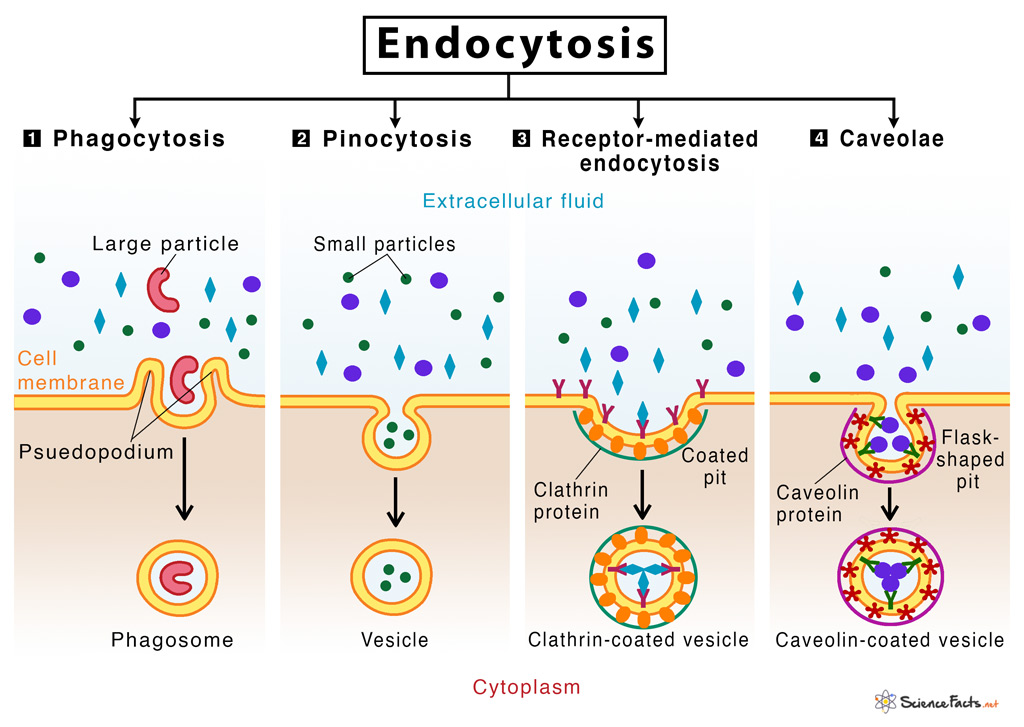Endocytosis
What is Endocytosis
Endocytosis is the process of bringing substances inside a cell from the external environment with the help of the cell membrane. Through this method, cells acquire nutrients required for growth and reproduction. It is a form of the active transport mechanism and thus needs energy, in the form of ATP, to proceed.
The word ‘endocytosis’ is derived from the Greek words ‘endon’, meaning ‘within’, ‘kytos’, meaning ‘cell’, and ‘-osis’, meaning ‘process’. The process was first proposed and described by cytologist Christian De Duve in 1963.
Examples of Substances Transported Using the Process
Substances like fluids, electrolytes, proteins, and other macromolecules are taken up inside the cell using endocytosis.
How Does It Work
Endocytosis works in three basic steps:
- The cell membrane folds inward, forming a cavity that contains fluid, dissolved substances, food materials, foreign matter, microorganisms, and some other substances. This process is known as invagination.
- The cell membrane then folds back on itself until it forms a uniformly enclosed membrane around the trapped molecules, forming a vesicle.
- The vesicle gets detached from the cell membrane, which is then processed by the cell.
Types of Endocytosis
1. Phagocytosis
Also known as cell eating, it is a form of endocytosis that works by engulfing large foreign cells or particles. A cell undergoing phagocytosis is known as a phagocyte.
Steps Involved in Phagocytosis
- Detection: This is the first step during which the phagocyte identifies the foreign substance, the antigen, and move towards the target cell.
- Attachment: The phagocyte then makes contact and attaches to the target cell. This binding initiates the formation of pseudopodia, an extension of the cell membrane that helps to surround the target.
- Ingestion: The surrounded target cell gets enclosed within a vesicle when the membrane of pseudopodia fuses. This vesicle enclosing the target is called a phagosome.
- Fusion: The phagosome then gets fused with the hydrolytic enzymes of the lysosome in an animal cell, to form a structure called phagolysosome. Lysosomes thus help to digest the materials contained within the vesicle.
- Elimination: This is the final step during which the digested foreign particle gets expelled from the cell.
Example
Immune cells such as white blood cells take up antigens such as viruses, bacteria, or dead cells, digest the content and move the digested material outside the cell.
2. Pinocytosis
Also known as cell drinking, it is the process by which small particles such as fluids and dissolved nutrients are taken up within the cell. Pinocytosis follows the same basic steps of endocytosis involving vesicle formation and transport. Once inside, the vesicle either combines with the lysosome or the cell membrane. Lysosomes then degrade the trapped molecules within the vesicles, thus releasing them into the cytoplasm. The cell undergoing pinocytosis is called a pinocyte.
Example
Absorption of fat droplets in cells lining the small intestine.
3. Receptor-mediated endocytosis (Clathrin-mediated endocytosis)
It is a selective process used by all cell types to take up specific molecules with the help of membrane receptor proteins present in the cell membrane. The membrane receptors are coated with a special type of protein called clathrin that helps to trap the substance by forming a vesicle around it. The vesicle then fuses with membrane-bound sacs called endosome that removes the clathrin coating from the vesicle, thus releasing the contents into the cytoplasm.
Example
Uptake of cholesterol attached to low-density lipoprotein (LDL) inside the cell.
4. Caveolae
It is located in the cell membrane of specific cell types such as smooth muscles, adipocytes, fibroblasts, and endothelial cells. Caveolae are small flask-shaped pits resembling tiny caves. In this process, the cells take up molecules using a cholesterol-binding protein called caveolin present in the cell membrane. The remaining procedure is similar to receptor-mediated endocytosis.
Example
Internalization of the insulin receptor in adipocyte cells.
FAQs
Ans. Amoeba uses endocytosis to take up nutrients and food particles inside the cell from its surrounding medium.
Ans. Endocytosis occurs due to an inward folding of the cell membrane, forming a vesicle that helps to take up the foreign substance. This process is absent in plant cells due to the presence of a rigid cell wall outside the cell membrane, and thus, it is found only in animal cells that are devoid of a cell wall.
Ans. The main difference between the two processes is that endocytosis involves the transport of particles or substances inside the cell from the outside environment by engulfing them with the help of their cell membrane. In contrast, exocytosis involves the process when cells release their content outside the cell with the help of vesicles that fuse with the cell membrane.
-
References
Article was last reviewed on Saturday, August 22, 2020




